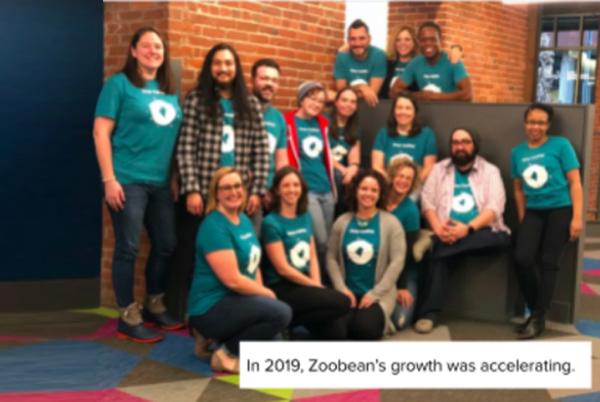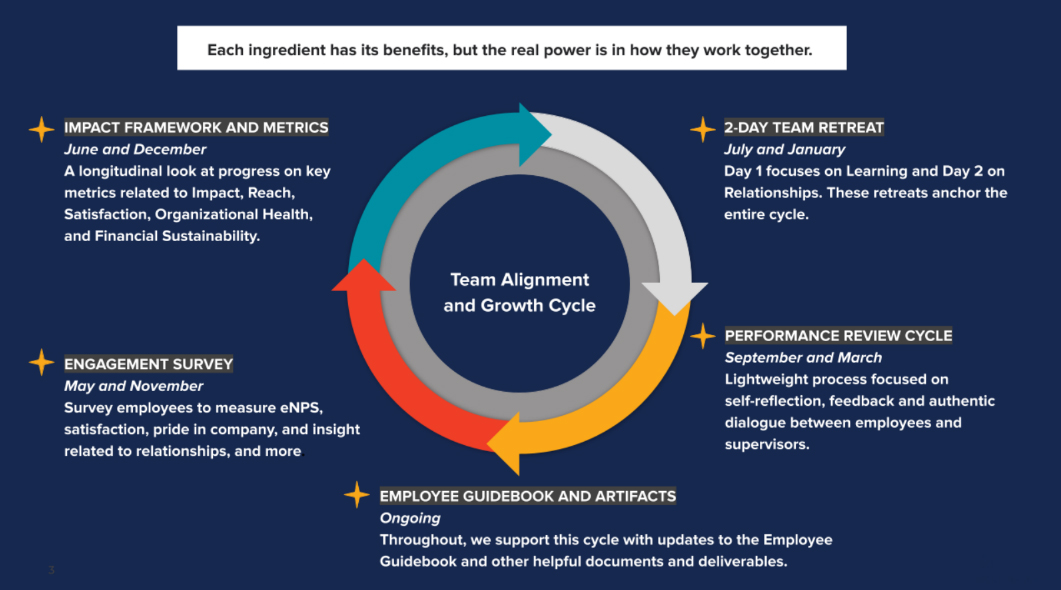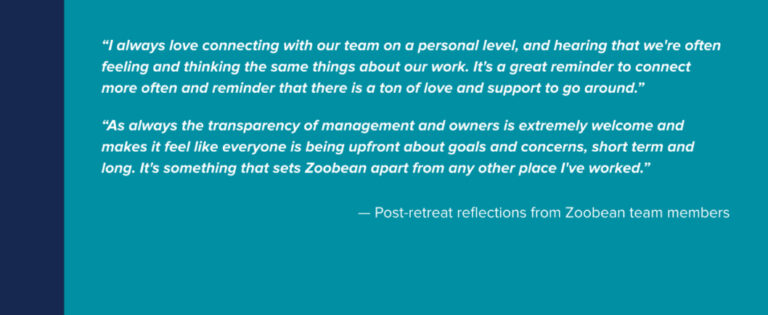Scaling Team Culture, Alignment, and Performance
Zoobean's momentum was starting to compound
The education technology startup had found product market fit for its reading challenges platform, and grown to become the number one solution for public libraries. Then, the combination of COVID conditions and product improvements drove the fledgling SAAS company into overdrive.
They were scaling faster than ever in their existing market, while also being pulled into schools, who were beginning to use the Beanstack platform to facilitate reading challenges.
With all of this happening at once, Zoobean needed to grow their team, mature their internal systems, and scale the positive culture that had been core to their success. They needed to do all of this while also responding to a new volume of business, and the increasing complexity of day-to-day demands. What’s more, they needed to stay open to change and emergent opportunities even as their team felt increasingly overwhelmed with the tasks at hand.


They engaged Outside Angle to help optimize team alignment and performance.
For more than 18 months, Outside Angle has been helping Zoobean successfully navigate the challenges of scale. Company culture, performance, and team alignment have been our focus. Working with their team, we put in place an ongoing annual cycle that keeps the team inspired, connected, and aligned. It includes positive cultural touchstones, lightweight systems for employee feedback and performance management, and a simple impact framework that enables data-driven progress monitoring.
Semi-annual team retreats anchor this entire cycle, creating space for the whole company to learn together, take stock of progress, and deepen and repair relationships as the foundation for effective collaboration. We proactively manage these processes to make sure they are being used with fidelity, communicate directly with the entire company to move them along, and create a trusted independent outlet for cultural concerns and strategic support.
Together we built sustainable systems, tailored to the organization's people and culture.
Zoobean’s complete culture, team alignment, and performance cycle has five ingredients. Together, they help maintain alignment, improve culture, and maximize performance as the organization grows. Here is a quick overview of each:
- Two-day virtual team retreats in summer and winter. These retreats serve as the anchor for the annual team alignment and performance cycle. Employees come together virtually for two days to learn together, deepen and repair relationships, and get on the same page as they prepare to go into the next six month push. Day 1 typically focuses on learning, looking at the state of the company from all different angles. Day 2 focuses on relationships between team members and organizational health and culture.

- Flexible impact framework. In advance of each retreat we prepare a pre-read that takes a comprehensive look at progress towards success and sustainability. We utilize Outside Angle’s Universal Impact Framework, tailored to Zoobean’s unique context. This framework tracks progress across five domains to create a comprehensive picture of progress over time. We look at metrics related to Impact, Reach, Customer Satisfaction, Organizational Health & Performance, and Financial Sustainability. The majority of these metrics align to a KPI dashboard updated frequently in between the semi-annual retreats.
- Employee engagement survey. Twice a year we survey employees to measure enthusiasm (eNPS), satisfaction, pride in the company, and insight related to relationships, perceptions of management, and more. To keep it simple, we utilize the software tools they already have in-house (in this case Lattice) to host and deliver the survey. We time the survey so that the data can roll up into the impact framework and be shared at the team retreats.
- Semi-annual performance reviews. Also twice a year, we refine and administer a lightweight performance review process focused on self-reflection, feedback, and authentic dialogue between employees and supervisors. Again, we tailor this process to the context, and utilize tools already in-house. These performance reviews follow the team retreats so that the team has the chance to reflect and align on the big picture before focusing on individual roles.
- Employee guidebook, and other supporting tools and artifacts. The processes above are supported by a toolkit of helpful documents and resources. One of the most important resources is the employee Guidebook, a hub of company information that is designed to reinforce the unique values and culture of the organization while providing all of the details employees are looking for related to their employment.
What makes all of this work is that the cycle is more than its component parts. Each ingredient
has its benefits, but the real power is in how they all work together towards the overall goal:
helping the team improve culture, align, and perform at its highest level.
Company pride and belonging have increased.
In the most recent employee engagement survey, 100% of team members agreed that they were proud to tell others that they are part of this company. Nearly 90% of employees agreed that all in all, they were very satisfied with their job, and the company achieved an 81 eNPS rating. We also learned that 100% of employees agreed that their coworkers want them to succeed, and 96% agreed that, at work, their opinions seem to count. These are extraordinary results for any organization, much less one in the thick of rapid change.

The leadership team is saving time and money.
By taking the nuts and bolts of this kind of system off the plate of the executive team, they are able to focus more energy on the things that only they can do, such as keeping the vision in focus, pursuing new opportunities, and planning for the future. Executive leadership is able to show up in these spaces focused on doing the work, not planning it. It also helps internal staff stay focused on the core business. At some point it may be necessary to have more staff dedicated to internal culture and performance, but for now, we’ve been able to effectively play that role at a fraction of the cost.
New tools and processes have been introduced right on time.
Another part of what makes this work is that Zoobean leadership invested in it when they needed it—not before, and not after. In our experience this is rare. Some organizations pull the trigger on this kind of work too early. We have seen many startups that want to be grown up before they need to be. They build and over engineer these kinds of systems before they even need them.
Much more common is erring on the other side—not building these kinds of healthy systems until it is too late. By then relationships are fractured, culture is compromised, and the new tools and processes are too little (or too much) too late. Zoobean leadership understood the need to create these systems right on time, just as they became helpful.

Relationships have remained positive through challenging change.
In Michael Fullan’s book Leading in a Culture of Change, he writes: “If you asked someone in a successful enterprise what caused the success, the answer almost always is ‘It’s the people.’ But that’s only partially true: It is actually the relationships that make the difference” (p. 63).
This is core to our philosophy and we design all elements of this cycle with relationships in mind.
During the team retreats we dedicate time to learning about each others’ personal journeys. During the performance review cycle we keep the focus on building strong, collaborative relationships between employees and supervisors. In the employee engagement survey, we probe on the extent to which relationships are healthy and trusting. At Zoobean we believe they are, and we think this is a major contributor to their positive momentum.
Every organization should pay attention to Zoobean’s story.
We believe that every organization, regardless of size, field, or structure, would benefit from having a lightweight system like this one. One ingredient—for example, implementing only an employee survey—is not enough. In fact, in isolation those tools are typically over-designed and may even be detrimental to culture and connection. When these lightweight tools work as a connected system, tailored to the organization’s context and culture, they can strengthen relationships, build trust, focus strategy, and create space for important conversations in a way that reduces friction elsewhere, and allows for increased focus on the work at hand. Engaging an outside organization to do this work can further increase efficiency, save money, and help your organization through any kind of challenging change.

Learn more about Zoobean, a great company helping people read more, and read together.

Zoobean’s Beanstack platform helps libraries, schools, and businesses manage and customize collaborative reading challenges for their patrons, students, or employees. It’s an awesome way to encourage reading, and reading together. We have our own Outside Angle Beanstack microsite that allows us to share what we’re reading, participate in reading challenges, track our individual reading data, and more.
Learn more at beanstack.com.
Learn more about Outside Angle and how we create systems that help teams perform.

Can you relate to Zoobean’s story? Introduce us to your team and we will help them build the culture, trust, relationships, and systems to perform at the highest level. We help teams identify and secure quick wins, solve problems and build lightweight flexible systems for monitoring progress, maximizing individual performance, creating high-impact relationships, and building the internal capacity to make change happen.
Contact Sarah Silverman at sarah@outsideangle.com. Learn more at outsideangle.com.
